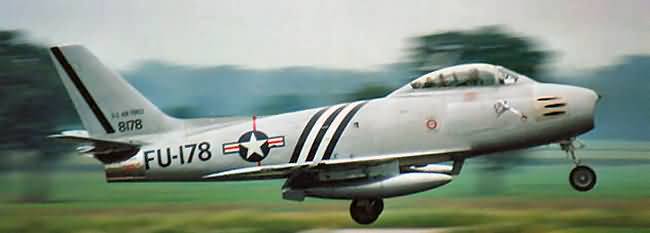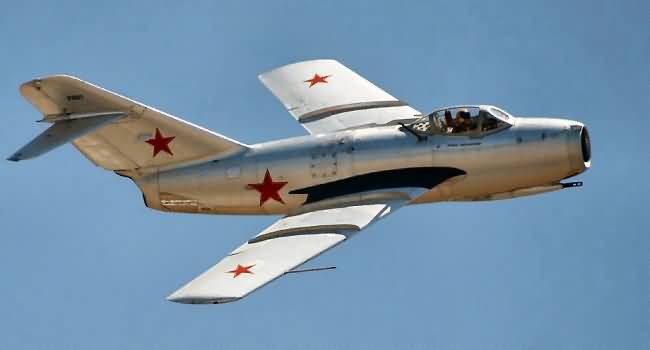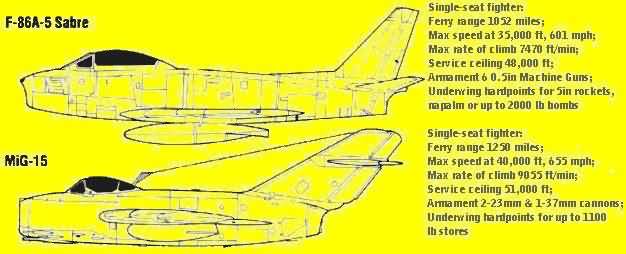 | After being discharged from the Navy and PHIBPAC in 12/51, I was privileged to serve as radar tech rep with 606th AC&W Squadron in 1952-53. We were located at K14, at the Han above Kimpo Air Base, with the whole 1st Marine Division between us and the Chinese armies, and provided radar coverage of the skies over North Korea. We helped alert our F-86 Sabres to MiG squadrons there, and to make MiG interceptions, as well as provide position information for all UN aircraft. |  When operating over northwestern Korea, in "MiG Alley", the Sabres' range restricted them to some 20 minutes over the Yalu, whereas the MiG-15s were within a few minutes flying time of their bases in Manchuria. Apart from the Sabre's range problems, it was also inferior to the MiG-15 in various aspects of performance.
| This page is part of a web site primarily intended to provide a little information and background on Infantry small arms used during the Korean War, together with some history links and an obtainable bibliography. Still, the overwhelming air superiority UN forces enjoyed over all ground combat centers was of such vital importance that it must be mentioned. Our air surveillance and attacks always kept the slender Communist logistics lines under maximum pressure, as well as restraining their troop movements to the night. And, at night, suspicious supply routes were illuminated by "Lightning Bug" C-47s. They dropped parachute-flares which provided four to five minutes of brilliant illumination, which were immediately exploited by our bomber and fighter-bomber strikes. Their armor and rolling stock were virtually at our mercy. During five days of the Chinese Communist advance (1/1/51-1/5/51), Fifth Air Force claimed 8,000 Communist troops as casualties. During the entire advance, they claimed 40,000 casualties. During their fighting withdrawal from Chosin, Marines were virtually escorted by prop-driven F4U Corsairs. When the Korean War ended(?) with a Cease Fire on 27 July, 1953, the air units of the USAF, US Navy, US Marine Corps and allied air forces had flown 1,040,708 sorties. They had succeeded in mastering the enemy air forces to such an extend that UN ground forces had seldom come under air attack. Conversely, communist troops were harassed night and day by air attacks ranging in scope from massed raids by B-29 bombers to strafing runs by fighter-bombers. Tactical air power was therefore a key to this conflict. Given the impossibility of discussing this air activity in detail, this discussion will just touch on the two principal antagonists in the air battles for which I was one trivial cog of the background: the F-86A-5 Sabre and the MiG-15.
The primary missions of our Air Force during the KW were armed reconnaissance, close air-support and interdiction. The versatile F-84 Thunderjet fighter-bomber combined good range characteristics - 670 miles when carrying wingtip tanks - with a heavy armament of six calibre .50 MGs, plus up to 4,000 lbs of bombs or rockets. This meant the F-84 could carry out all primary missions with equal facility, plus had the range, firepower and maneoeuverability to fly bomber escort. One of the significant results of China's entry into the war was the resurgence of communist air power. MiG-15 jet fighters operating from airfields around Antung in Manchuria, which was off-limits to US air attack, many flown by Soviet instructors to the Chinese, established ascendence over the F-84, B-29s and other prop-driven UN aircraft. |  | This ascendency was quickly challenged, and from then on the primary battles in the skies of North Korea were between the MiG-15 and the F-86A. The MiG could outclimb the Sabre at all altitudes, although the latter was marginally faster in level flight. The MiG's greater operational ceiling gave it an initial advantage in combat, yet although it had a greater initial acceleration in a dive, the heavier Sabre had the advantage in a sustained dive. The MiG's zoom climb and tight turning characteristics (except at high speeds) were valuable, but the fighter's good points were counterbalanced by such undesirable features as poor control at high speeds, a low rate of roll and directional instability at high altitudes. Its heavy armament (two 23mm and one 37mm cannon) was better suited to bomber interception than to fighter-vs-fighter combat; but the Sabre's six 0.5 cal MGs, while having a faster rater of fire, lacked the range and hitting power necessary for jet combat. On the plus side, the Sabre had the marvelous K14 radar gun-sight, which gave enormous assistance to our pilots, particularly in derivative movement information of enemy aircraft, which gave invaluable lead-time in dog-fights. Sabres operating in MiG Alley faced large formations of 50 to 70 enemy fighters flying at heights of 50,000 ft or more, which the American fighters could not match. This meant that the US fighter pilots had to evolve tactics to cope with a "bounce" by fast-flying MiGs diving down on them from high altitude at a time and place of the enemy's choosing. The solution was the "jet stream" of 16 Sabres divided into four-aircraft flights, each of which entered the Alley at five-minute intervals and at different altitudes between 27,000 and 33,000 feet. The Sabres flew at high speed (typically Mach 0.87, so as soon as one flight was engaged by the MiGs the others could rapidly converge on the combat. The flights adopted a "fluid four" tactical formation, comprising two element leaders each covered by a wingman. So, although operating at a considerable initial disadvantage against the high-flying MiGs, the mutually supporting Sabre formations were able to meet the MiG's bounce with a vigorous counter-attack. The Sabre's combat record in Korea was, by any standards, impressive. Of the 900 aerial victories claimed by USAF pilots during the war, 792 were MiG-15s shot down by Sabres. The MiGs in their turn managed to knock down only 78 Sabres. American fighter pilots thus established a ten-to-one kill/loss ration in their favor. Documented postwar research indicates there were actually only about 379 US victories. The Soviets claimed to have shot down more than 650 Sabres, while USAF records show 224 F-86s lost to all causes, including non-combat. Whatever the actual victories and losses F-86 pilot-performance in combat was remarkable, quite an accomplishment, against the odds. Bert Kortegaard |  |
Air Interdiction Effectiveness
Causes of the Korean Tragedy ... Failure of Leadership, Intelligence and Preparation
The Foundations of Freedom are the Courage of Ordinary People and Quality of our Arms
| |


